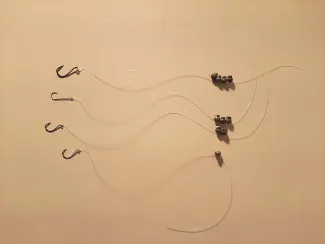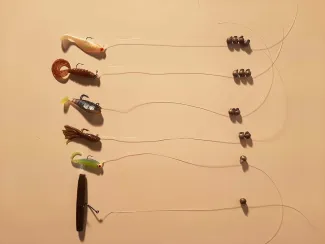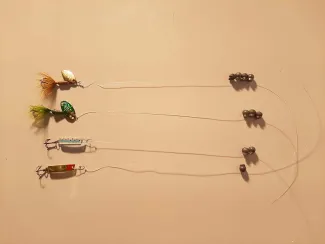Have you ever used split shot on your fishing line? I'm a big believer in downsizing your bait or lure profile to catch more fish overall and using split shot is the simplest and most effective way to do so.
There are lots of techniques that allow you to get your bait or lure deeper in the water column to keep it in the "strike zone" longer during the retrieve. However, these options, such as the Carolina-rig, Texas-rig or Drop Shot-rig, often require specialized equipment to fish them efficiently. Plus, these techniques typically call for larger bait profiles.
Any basic rod and reel combo, 10-lb test line and under, is perfectly suited for using a split shot-rig.
Split shot comes in various sizes ranging from B (1/96th ounce) to #0 (1/4th ounce). Size #7 (1/24th ounce), size #5 (1/13th ounce) and size #3 (1/10th ounce) are most commonly used.
But why add weight to the line when you could just use a heavier lure or bait option? Well for starters, fish in public bodies of water have pretty much seen every standard 3-5" soft plastic bait in every color, fished every which way. Small-sized internally weighted or lipped hard baits tend to fish too high in the water column and heavier jigheads often have too long of a hook shank to use with the smaller-sized lure and bait profiles we are going to discuss.
Let's start with live bait. Most are familiar with the basic hook, split shot and fixed bobber-rig used to fish one to two feet below the surface with a worm or minnow for panfish and the occasional bass or catfish. This technique is particularly effective in April, May and early June in Oklahoma, but the rest of the year, fish typically hang out closer to the bottom near vegetation and hard structure. A traditional Carolina-rig often calls for weight that is too heavy to indicate subtle bites or bites from smaller fish. Three to four pieces of split shot applied directly to the line a foot above the hook allievates this problem in water 6-15 feet and one to two pieces of split shot in water less than 6 feet.

I prefer to use a wide-gap octopus hook when fishing with live bait off the bottom with split shot. A size 1 or size 2 wide-gap octopus hook is the perfect all-around size for panfish all the way up to catfish, drum and carp. A size 4 or size 6 plain shank Aberdeen hook can be used as a substitute.
Red worms and 2-3" minnows work best when using a smaller profile rig.
Thread half of your worm onto the hook shank allowing the other half to "swim freely" as an extra attractant in addition to the scent of the worm. For live minnows, work the hook point into the minnow's mouth and expose the hook point through the roof of the mouth between the nose holes. This allows the minnow's bottom lip to stay open, which helps keep your minnow alive longer. You can also put the hook through the top of the minnow's back right behind the dorsal fin.
The only downside to fishing with split shot off the bottom is when you are near heavily wooded areas, such as brush piles, where the split shot and line is easily susceptible to tangling around branches. Otherwise, it is great for just about any other type of bottom structure.
When you have your live bait split shot-rig ready, simply cast to a specific spot and leave your reel bail open until your bait reaches the bottom. Then close the bail, reel up any slack in the line and wait for a bite. A substitute for split shot if you plan to slowly retrieve your live bait after each cast is a walking or snag-free weight, but don't use more than a 1/4th ounce weight.
Using split shot also eliminates the need for a swivel and leader line, which is needed for heavier weights. You can also add or remove weight easily without having to do any type of re-tying. A fish can pick up your bait on a split shot-rig without noticing the light weight, which leads to better hook-sets and more fish landed.
When fishing near-shore, split shot is instrumental in picking up more bites on artificial lures when fish are congregated towards the bottom. Swimbaits, grubs, tubes and inline spinnerbaits in the two-and-a-half inch and smaller variety can be difficult to fish naturally near the bottom if too much weight is applied to the jighead or main line. One to four pieces of split shot, depending on depth and split shot size, placed on the main line a foot above your lure is the ideal way to stay in the "strike zone" for the majority of your retrieve.
I like 1.5-2.5" baby shad, sassy shad, naturally colored tubes and grubs paired with a 1/32nd or 1/16th ounce jighead or a 1/16th ounce naturally colored inline spinnerbait. I place one to four pieces of split shot, depending on depth and split shot size, on the main line one foot above the lure. Cast your lure to a specific spot and leave the reel bail open until the lure reaches the bottom. Then close the bail and begin a slow steady retrieve. With inline spinnerbaits, give a quick hook set motion when you first engage the reel to get the blade spinning.

Fish, especially pressured or finicky fish, seem more willing to take small offerings. First off, it opens up the size of fish you can catch. You immediately eliminate half the fish you would have caught when you use bait profiles larger than three-inches. Secondly, small naturally colored lures are less intimidating and therefore not overly examined by the fish prior to committing, which leads to more aggressive bites and ultimately more fish hooked. Lastly, and arguably most importantly, fishing smaller profile baits forces the angler to slow down. Outside of a few select periods during the year, fish are just unwilling to chase after a meal thats moving too fast.
The majority of fish in a given body of water are prey to something bigger, so they will not stray far from the safety of cover and structure. By using a small, slowly retrieved lure, you're tapping into a fish's instinct of taking an easily consumable, unsuspecting or lost baitfish.
You want your lure to glide through the water with an occasional pop of the rod tip to create a darting or fleeing motion. Baitfish are sleek and agile. Predators can spot any lack of realism, which results when you try to slowly retrieve heavier jigheads or weight with a small profile bait. This is beacuse either a) the slow retrieve accompanied with heavier weight causes you to snag the bottom or b) in order to keep from getting snagged on the bottom you have to increase your retrieve speed to the point that fish are unwilling to give chase.
Downsizing the profile of your bait will not eliminate the opportunity to catch big fish. In fact, some of the largest game fish I have caught in Oklahoma have come on bait profiles less than three-inches paired with 1/16th ounces of weight or less.
The split shot-rig is a great way to build confidence as an angler, especially when using artificial lures and baits. It is the foundational building block for expanding into all of the other fishing techniques. The biggest barrier I see when anglers are not catching fish is that they are fishing too fast or are using too large a lure for the body of water or species they are targeting.
The split shot-rig is super-effective for inline spinnerbaits, super dupers and spoons when fishing moving water for trout. One to two pieces of split shot, placed on the main line, a foot above a 1/16th ounce lure is perfect for staying in the middle of the water column, right where trout like to attack. Cast slightly upstream, across the current, and immediately begin a slow, steady retrieve. Inline spinnerbaits, such as original and vibrating rooster tails, in olive or brown are my go-tos for wintertime trout. Super dupers in gold or rainbow trout and spoons in gold and orange are also effective.

Focus your fishing efforts in water less than 15 feet deep near areas with lots of bottom structure and cover, such as rip rap, rocky points, brushy shoreline, marinas and docks. Stick to naturally colored artificial offerings. To get the most out of your fishing experience, bring a cup of worms or a bucket of minnows so that you can fish at least one set line with live bait, doubling your odds for success.
Until next time, tight lines my fishing friends!
SPLIT SHOT-RIG FOR BASS
Bass fishing with split shot typically requires only one piece of split shot and can be used with a wide variety of soft plastic baits and hooks. The most common set-ups are with a stick worm on a wacky-rig hook and creature baits on an off-set hook. The split shot-rig for bass is a finesse technique and is fished with pops and pauses instead of a slow steady retrieve.



